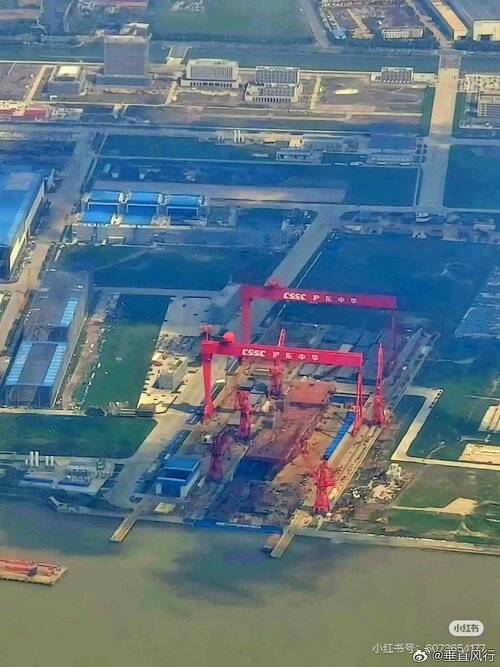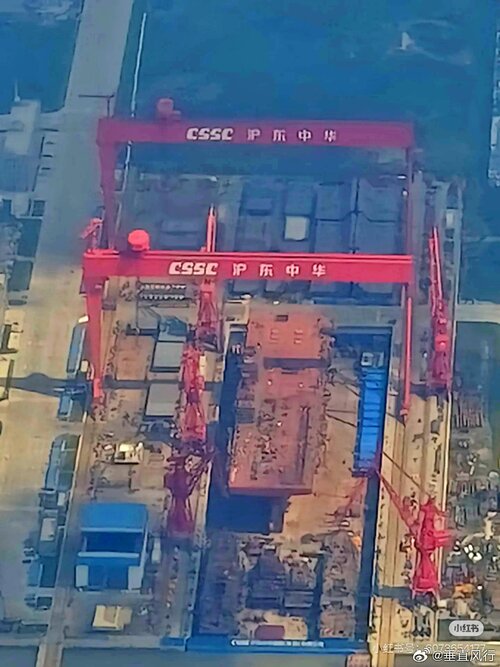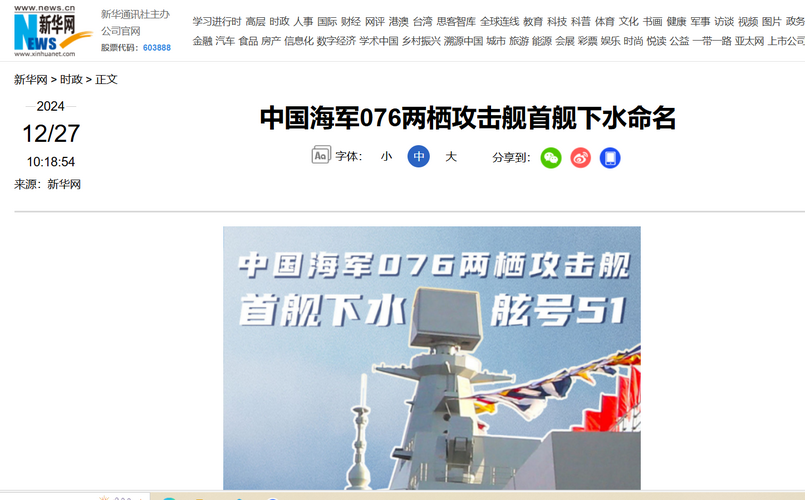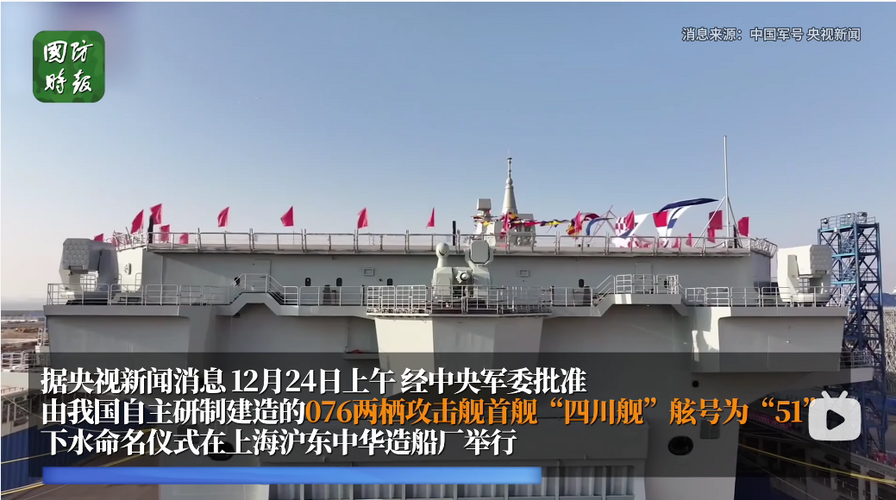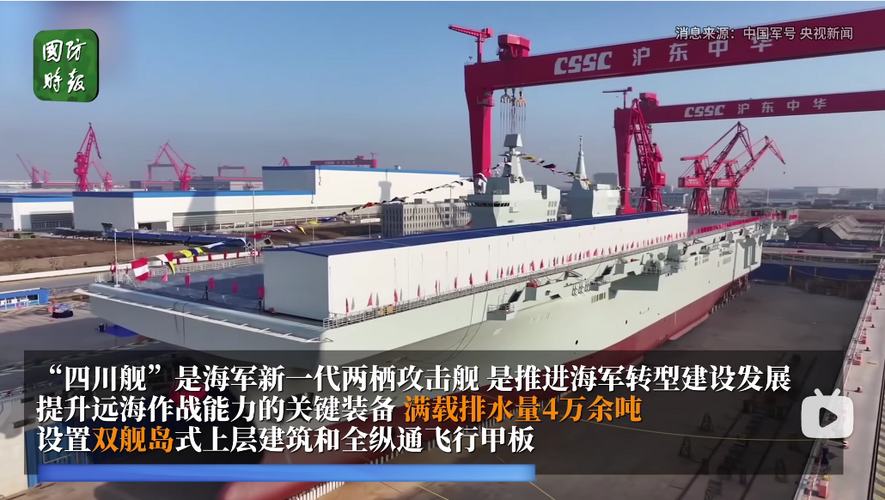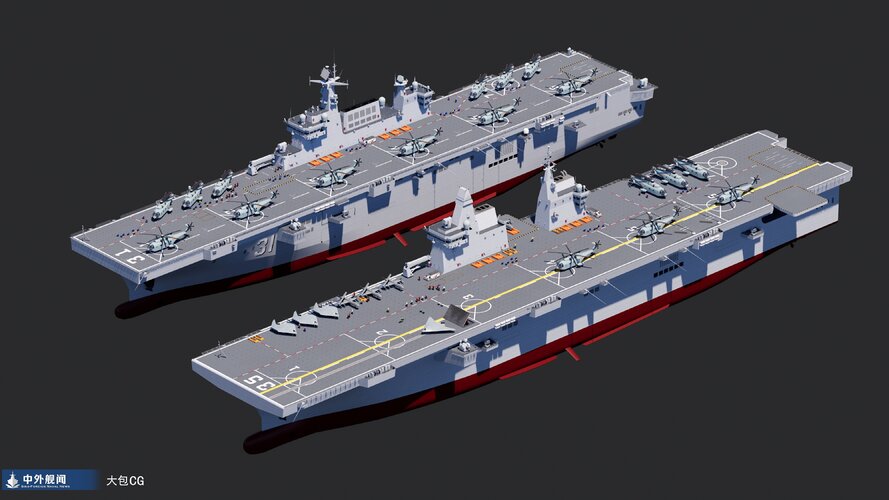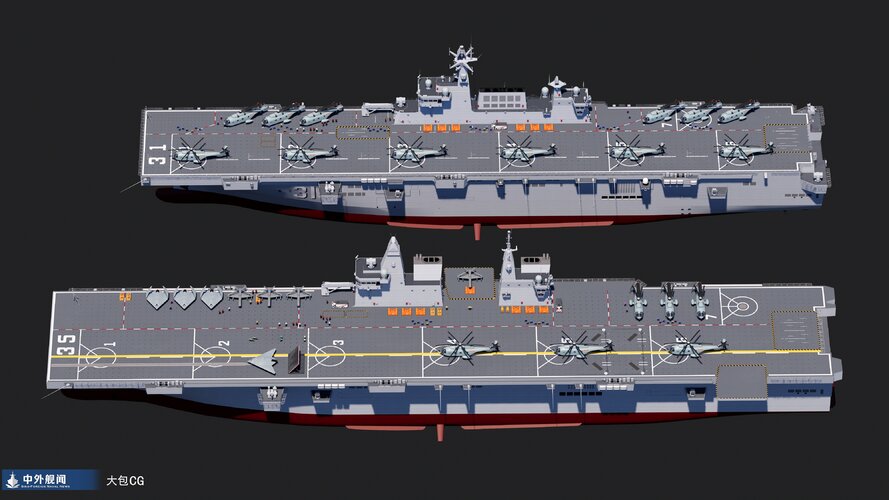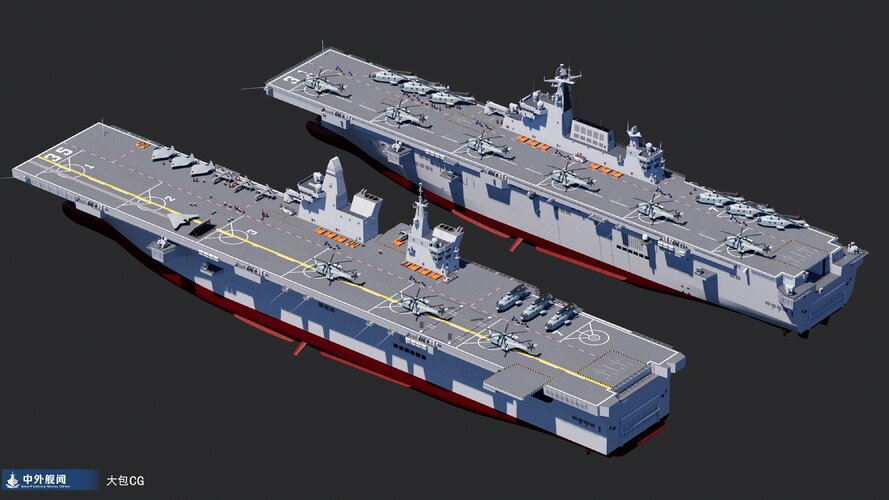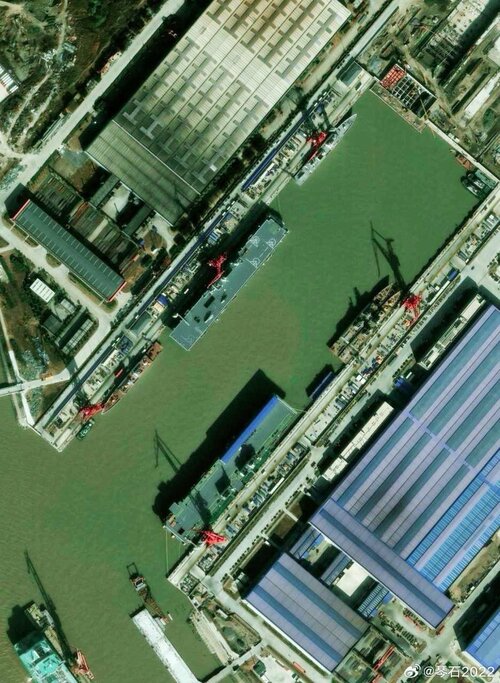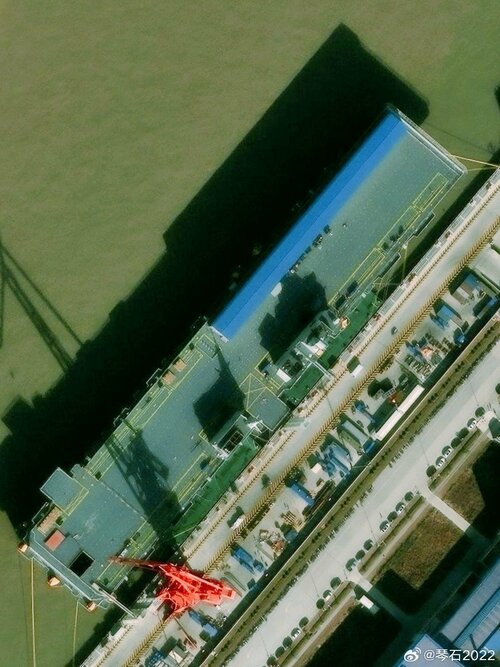You are using an out of date browser. It may not display this or other websites correctly.
You should upgrade or use an alternative browser.
You should upgrade or use an alternative browser.
China's PLAN Type 075 LHD & future Type 076 LAH
- Thread starter dan_inbox
- Start date
snne
ACCESS: Top Secret
- Joined
- 3 July 2022
- Messages
- 1,384
- Reaction score
- 4,495
Forest Green
ACCESS: Above Top Secret
- Joined
- 11 June 2019
- Messages
- 9,467
- Reaction score
- 17,275

China’s Monster Amphibious Assault Ship Has Twin Island Superstructures Optimized For Aviation Ops
The twin island superstructures would make the huge Type 076 even more suitable for accommodating a diverse air wing. The twin island superstructures would make the huge Type 076 even more suitable for accommodating a diverse air wing.
Forest Green
ACCESS: Above Top Secret
- Joined
- 11 June 2019
- Messages
- 9,467
- Reaction score
- 17,275

China's Monster Type 076 Amphibious Assault Ship Seen Like Never Before At Launch Ceremony
Despite a launch ceremony, the Type 076, now named Sichuan, do no look to have gone into the water, but that milestone looks to be imminent.
FighterJock
ACCESS: Above Top Secret
- Joined
- 29 October 2007
- Messages
- 5,596
- Reaction score
- 5,921
That ship certainly looks huge Forest Green, how does it compare with its US equivalents?
Forest Green
ACCESS: Above Top Secret
- Joined
- 11 June 2019
- Messages
- 9,467
- Reaction score
- 17,275
Seems to be the same length but wider, probably more similar to the Japanese JS Kaga.That ship certainly looks huge Forest Green, how does it compare with its US equivalents?
- Joined
- 22 January 2006
- Messages
- 4,212
- Reaction score
- 2,007
"Official media announced a displacement of over 40,000 tons for the new amphibious carrier. “Sichuan” is notably larger in all dimensions than the preceding Type 075-class LHD. The hull is approximately 260 metres long, with a beam across the flight deck of circa 50 meters. In overall size Type 076 is therefore comparable to current American amphibious assault carriers such as the Wasp- and America-class."That ship certainly looks huge Forest Green, how does it compare with its US equivalents?

Type 076 Amphibious Carrier Launched By Hudong In Shanghai
China today launched the innovative new Type 076 amphibious carrier equipped with an electromagnetic catapult and named it "Sichuan".
FighterJock
ACCESS: Above Top Secret
- Joined
- 29 October 2007
- Messages
- 5,596
- Reaction score
- 5,921
Thanks for the info Antonio, I did not realise that the Type 056 was similar to the Wasp and America class in terms of size.
"Official media announced a displacement of over 40,000 tons for the new amphibious carrier. “Sichuan” is notably larger in all dimensions than the preceding Type 075-class LHD. The hull is approximately 260 metres long, with a beam across the flight deck of circa 50 meters. In overall size Type 076 is therefore comparable to current American amphibious assault carriers such as the Wasp- and America-class."

Type 076 Amphibious Carrier Launched By Hudong In Shanghai
China today launched the innovative new Type 076 amphibious carrier equipped with an electromagnetic catapult and named it "Sichuan".www.navalnews.com
Damn chineses, this is heavier and bigger than CdG !
- Joined
- 28 January 2008
- Messages
- 1,015
- Reaction score
- 2,195
I thinks it a Chinese, evolved variation of the HMS Queen Elizabeth. OK for all, let's all come up with some nice, serious CGI concepts with realistic combat potential then we'll see who's get selected by the Chinese to build!
Forest Green
ACCESS: Above Top Secret
- Joined
- 11 June 2019
- Messages
- 9,467
- Reaction score
- 17,275

China unveils amphibious assault ship that can launch fighter jets
The Sichuan is equipped with an electromagnetic catapult that will allow fighter jets to launch directly off its deck.
- Joined
- 2 January 2006
- Messages
- 3,824
- Reaction score
- 5,114

China unveils amphibious assault ship that can launch fighter jets
The Sichuan is equipped with an electromagnetic catapult that will allow fighter jets to launch directly off its deck.www.defensenews.com
Wait, so this is China answer to the Marines "F-35B turns big amphibs into light carriers" ?
https://www.defenseone.com/threats/...ine-corps-can-fly-more-f-35bs-amphibs/365563/
1- Smart move, they replace "VSTOL" with "EMALS". And that way, you can bet J-35s will be carried. A plane not that dissimilar to the F-35.
Things are coming full circle - and symmetrical, just like in the Cold War when every US move triggered a parallel Soviet development (F-15 & Su-27, Buran & Shuttle, countless others)
2- Sticky point: EMALS allows catapults on big amphibious ships... something steam catapults couldn't do. They were just too big electromechanical machinery.
3- The chinese are smart. They skipped steam catapults and VSTOL - for EMALS. More pointedly: the naval J-35 skipped the F-35C's steam catapults and the F-35B's VSTOL... going directly to EMALS.
4-Put otherwise: the US military put EMALS on their supercarriers and twenty F-35B on their largest amphibious ships to make them CVLs. --The chinese put EMALS on their largest amphibious ships so that J-35 can use them, making them CVLs too.
Last edited:
Ainen
I really should change my personal text
- Joined
- 25 August 2011
- Messages
- 1,251
- Reaction score
- 1,676
EMALS helps to take off(arguably lesser problem anyway for a higher T:W aircraft), it doesn't help to land(which is in fact a bigger problem). So while EMALS is indeed revolutionary*, i still wonder about what do they mean.
Also, while purpose-built LHAs never carried cats, converted Essexes did.
*and frankly i'm looking forward to possible resurgence of interwar style cats on surface combatatants.
Also, while purpose-built LHAs never carried cats, converted Essexes did.
*and frankly i'm looking forward to possible resurgence of interwar style cats on surface combatatants.
- Joined
- 6 November 2010
- Messages
- 5,261
- Reaction score
- 5,503
Wasn't that solved with arrestor wires very early in aircraft carrier development? What am I missing?EMALS helps to take off(arguably lesser problem anyway for a higher T:W aircraft), it doesn't help to land(which is in fact a bigger problem).
Hi,
When looking at the notionalimages provided above I believeone concern is that the vessels appear to be solely axialdeck vessels. As such, this may significantly impact air operations. Specifically, during landing operations it would appearthat all the port side helo spots would have to be kept clear, as well as (likely) the launch postion,in order to allow for the potentialn "bolting" of any plane that either misses the landing wires or has to abort at the last minute. Due to the vessel'swide breadth there may be sufficient space to starboard to relocate any helos, but conducting fixed wing operations would appear to likely greatly impact the ability of the ship's other potntial missions such as loading ,launching and retieving any troop carrying helicopters.
In addition, if the arrestor wires are stretch across the aft of the ship it is unclear if this would potentially cause any issues with loading and unloading of troop carrying helicopters, as the presence of the wires may present issues with maneuvering the helicopters to the aft port side launch/recovery position and may also be an impediment to safe troop movement on deck.
And finally during any jet launch I was suspect that the port side would stillhave to be maintained clear of helicopters to allow for the potential emergancy recovery of the jet in the event of a mishap during launch. As such, As such in a combine jet and helo configuration operations may be in some ways limited and it is possible that the ships may only be intended to carry a very limited number of jets (if any) for a limited role.
On the other hand, it is possible however that the vessel configuration is intended to allow the ship to be able to quickly be reconfigured in an either/or manner, where the vessel is either intedned to operate as a truly fully amphious assualt ship or it could operate as a jet carrying sea control ship, but not atthe same time.

When looking at the notionalimages provided above I believeone concern is that the vessels appear to be solely axialdeck vessels. As such, this may significantly impact air operations. Specifically, during landing operations it would appearthat all the port side helo spots would have to be kept clear, as well as (likely) the launch postion,in order to allow for the potentialn "bolting" of any plane that either misses the landing wires or has to abort at the last minute. Due to the vessel'swide breadth there may be sufficient space to starboard to relocate any helos, but conducting fixed wing operations would appear to likely greatly impact the ability of the ship's other potntial missions such as loading ,launching and retieving any troop carrying helicopters.
In addition, if the arrestor wires are stretch across the aft of the ship it is unclear if this would potentially cause any issues with loading and unloading of troop carrying helicopters, as the presence of the wires may present issues with maneuvering the helicopters to the aft port side launch/recovery position and may also be an impediment to safe troop movement on deck.
And finally during any jet launch I was suspect that the port side would stillhave to be maintained clear of helicopters to allow for the potential emergancy recovery of the jet in the event of a mishap during launch. As such, As such in a combine jet and helo configuration operations may be in some ways limited and it is possible that the ships may only be intended to carry a very limited number of jets (if any) for a limited role.
On the other hand, it is possible however that the vessel configuration is intended to allow the ship to be able to quickly be reconfigured in an either/or manner, where the vessel is either intedned to operate as a truly fully amphious assualt ship or it could operate as a jet carrying sea control ship, but not atthe same time.

Last edited:
Ainen
I really should change my personal text
- Joined
- 25 August 2011
- Messages
- 1,251
- Reaction score
- 1,676
For props yes, for jets not so much.Wasn't that solved with arrestor wires very early in aircraft carrier development? What am I missing?
Like, it worked in 1950s, but this isn't a kind of "worked" anyone would want.
Ainen
I really should change my personal text
- Joined
- 25 August 2011
- Messages
- 1,251
- Reaction score
- 1,676
Both parts of the same problem.I think you are confusing net barriers with arrestor wires.
Arrestor wires fail quite often, one way or another. With jet(no matter piloted or drone) on a straight deck it very often means disaster.
- Joined
- 6 November 2010
- Messages
- 5,261
- Reaction score
- 5,503
Not true. The tail hook not catching the wire is what usually causes a bolter, arresting gear failures are much rarer. I admit a bolter on a straight deck was a big problem, on an angled deck less so. Go around, try again on an angled deck.Arrestor wires fail quite often
A straight deck carrier is bad for cat and trap operations. Cat and trap works much better on an angled deck.
Scott Kenny
ACCESS: USAP
- Joined
- 15 May 2023
- Messages
- 11,537
- Reaction score
- 14,134
Still needs arresting gearWait, so this is China answer to the Marines "F-35B turns big amphibs into light carriers" ?
https://www.defenseone.com/threats/...ine-corps-can-fly-more-f-35bs-amphibs/365563/
1- Smart move, they replace "VSTOL" with "EMALS". And that way, you can bet J-35s will be carried. A plane not that dissimilar to the F-35.
Things are coming full circle - and symmetrical, just like in the Cold War when every US move triggered a parallel Soviet development (F-15 & Su-27, Buran & Shuttle, countless others)
1) That EMALS is only the catapults, not the arresting gear.Wasn't that solved with arrestor wires very early in aircraft carrier development? What am I missing?
2), The problem of aircraft landing on a straight deck, not stopping for whatever reason, and crashing into the deck park is what prompted the development of the angled flight deck to begin with.
- Joined
- 6 November 2010
- Messages
- 5,261
- Reaction score
- 5,503
Arresting gear has been around on aircraft carriers for about, oh, a hundred years. Plenty of time to mature and adapt to heavier, faster aircraft.1) That EMALS is only the catapults, not the arresting gear.
Bingo.2), The problem of aircraft landing on a straight deck, not stopping for whatever reason, and crashing into the deck park is what prompted the development of the angled flight deck to begin with.
Last edited:
Scott Kenny
ACCESS: USAP
- Joined
- 15 May 2023
- Messages
- 11,537
- Reaction score
- 14,134
IIRC, the Advanced Arresting Gear on the Ford-class has a wider range of safe landing weights that it can handle, so the Ford-class can safely recover relatively light UAVs in addition to very big/heavy aircraft.Arresting gear has been around on aircraft carriers for about, oh, a hundred years. Plenty of time to mature and adapt to heavier, faster aircraft.
You can get away with very early arresting gear designs for 35,000lb landing weight aircraft, but they would not necessarily be able to land a ~55klb landing weight aircraft.
- Joined
- 6 November 2010
- Messages
- 5,261
- Reaction score
- 5,503
@Scott Kenny Thanks. I had overlooked the lower weight limit for arresting gear.
Scott Kenny
ACCESS: USAP
- Joined
- 15 May 2023
- Messages
- 11,537
- Reaction score
- 14,134
It's an unusual thing to think about, for sure.@Scott Kenny Thanks. I had overlooked the lower weight limit for arresting gear.
So I'd be really surprised if the LHDs keep their axial deck if the Chinese want to use them as CVLs. It's just flat operationally safer, and while I doubt the CCP cares much about their people they definitely care about the chance of accidentally destroying most of the aircraft on the deck park!
- Joined
- 6 November 2010
- Messages
- 5,261
- Reaction score
- 5,503
If drones are the only craft launched by catapult/EMALS, and recovery - if needed at all - is by, say, parachute, a straight deck could suffice for an LHD. Any CTOL carrier aircraft, crewed or autonomous, would require arresting gear AND an angled deck. ESTOL aircraft could possibly do without either.
Tomboy
ACCESS: Confidential
- Joined
- 4 January 2025
- Messages
- 79
- Reaction score
- 300
There is no way a heavy UCAV such as the GJ-11 is going to be parachute recovered, they could just clear the part of the deck that is the way of the landing aircraft before recovery and I'm pretty sure there were some pictures over on SDF showing the mounts for arrestor cables.If drones are the only craft launched by catapult/EMALS, and recovery - if needed at all - is by, say, parachute, a straight deck could suffice for an LHD. Any CTOL carrier aircraft, crewed or autonomous, would require arresting gear AND an angled deck. ESTOL aircraft could possibly do without either.
- Joined
- 29 November 2010
- Messages
- 1,773
- Reaction score
- 3,474
im wondering how some of the smaller angled-deck carriers managed flight deck operations.
i.e. Foch-Sao Paolo, CdG, etc.
deck space is narrower and cramp, how many of the planes did they move off deck during landings?
with some of the catapults extended into the angled runway space, simultaneous take offs and landings seemed out of the question
i.e. Foch-Sao Paolo, CdG, etc.
deck space is narrower and cramp, how many of the planes did they move off deck during landings?
with some of the catapults extended into the angled runway space, simultaneous take offs and landings seemed out of the question
BlackBat242
OK, I changed my personal text ;)
- Joined
- 10 April 2013
- Messages
- 1,472
- Reaction score
- 4,258
im wondering how some of the smaller angled-deck carriers managed flight deck operations.
i.e. Foch-Sao Paolo, CdG, etc.
deck space is narrower and cramp, how many of the planes did they move off deck during landings?
with some of the catapults extended into the angled runway space, simultaneous take offs and landings seemed out of the question
Ask the Aussies or Canucks...
HMAS Melbourne S-2 Tracker on final with another on catapult:
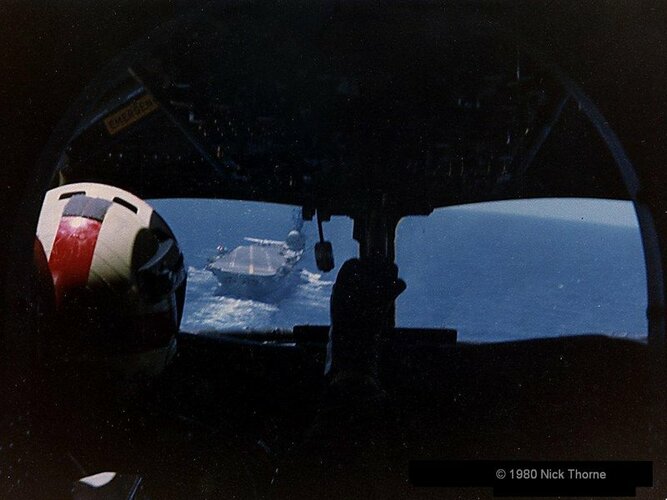
For size comparison:
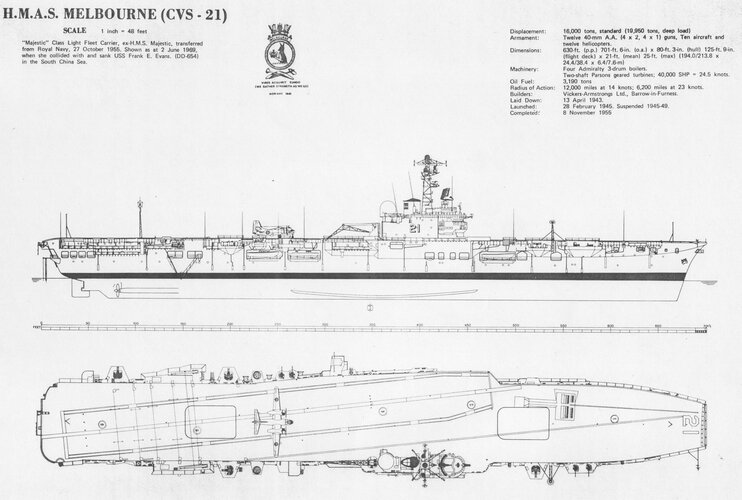
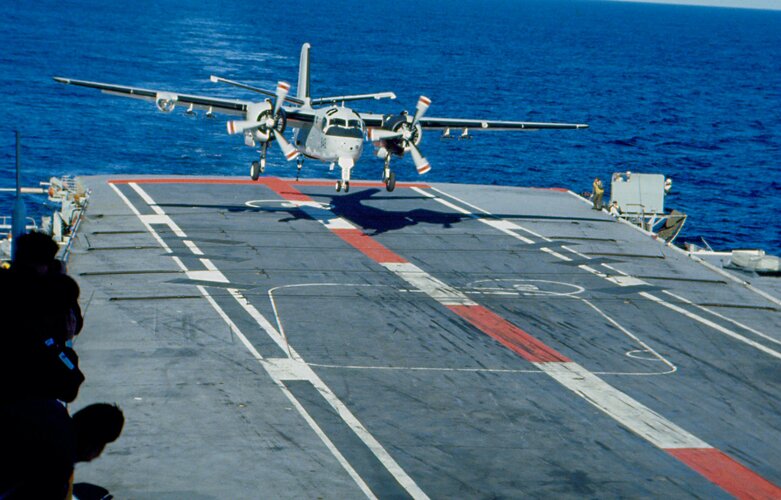
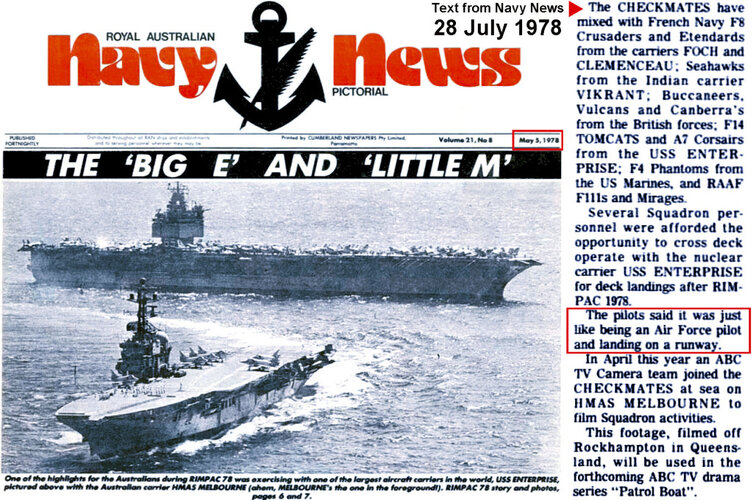
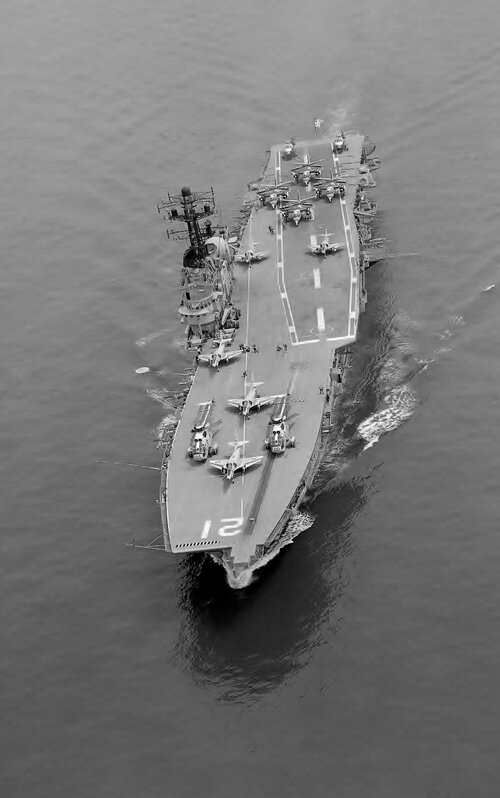
HMCS Bonaventure:
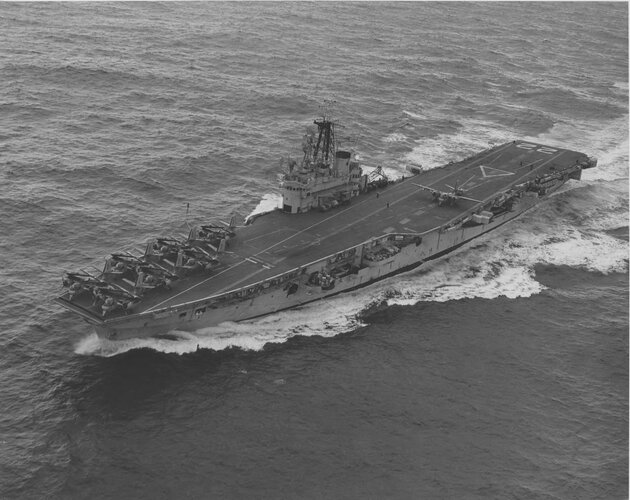
HMCS Bonaventure & USS Essex, both with S-2s on catapults:
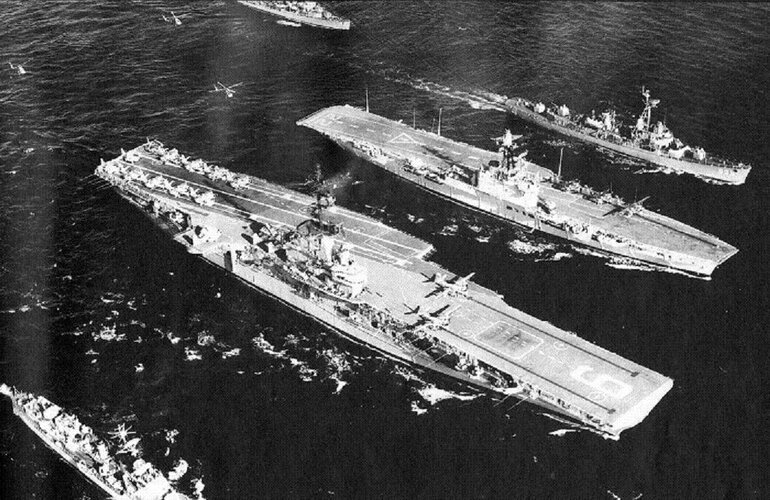
Avimimus
ACCESS: Top Secret
- Joined
- 15 December 2007
- Messages
- 2,426
- Reaction score
- 907
I'm curious what arguments might exist for the type 076 being an amphibious assault ship rather than a drone-centric ASW escort? Well dock for USVs?
The implied weight of a UCAV (based on the catapult), combined with the narrow deck width, might imply less than optimal configuration for a medium endurance patrol design - but I'm not sure a design that would be fit-for-purpose can be entirely ruled out on those grounds.
The implied weight of a UCAV (based on the catapult), combined with the narrow deck width, might imply less than optimal configuration for a medium endurance patrol design - but I'm not sure a design that would be fit-for-purpose can be entirely ruled out on those grounds.
Eagle2009
ACCESS: Confidential
- Joined
- 8 February 2010
- Messages
- 172
- Reaction score
- 239
I wonder if the Type 076's unique features would be compatible with carrying a small contingent of JL-10/L-15s (already planned for use on the CV-18) utilized in a light attack role?
They're light enough that landing shouldn't be much issue so as long as the EMALS can actually get it in the air...
We know they fitted at least one earlier L-15 variant with a PESA radar with likely useful enough capabilities to be used in such a role (including some limited A2A capes, unlike most UCAVs we've seen), shouldn't be difficult to integrate it into the CATOBAR intended JL-15 they're already developing.
Combined with pretty useful payload and range numbers, I can definitely see some value in it.
But I could see how that could be seen as a step back.
They're light enough that landing shouldn't be much issue so as long as the EMALS can actually get it in the air...
We know they fitted at least one earlier L-15 variant with a PESA radar with likely useful enough capabilities to be used in such a role (including some limited A2A capes, unlike most UCAVs we've seen), shouldn't be difficult to integrate it into the CATOBAR intended JL-15 they're already developing.
Combined with pretty useful payload and range numbers, I can definitely see some value in it.
But I could see how that could be seen as a step back.
Scott Kenny
ACCESS: USAP
- Joined
- 15 May 2023
- Messages
- 11,537
- Reaction score
- 14,134
I mean, having a small number of fighters for either BARCAP or Deck-Launched Intercept was identified as critical for the ASW carrier mission. But by "small" we're talking between 8 and a dozen, just to keep 2 birds aloft 24/7 for BARCAP. 8 birds can only do BARCAP for about 3-5 days before you need to pause to do deferred maintenance.I wonder if the Type 076's unique features would be compatible with carrying a small contingent of JL-10/L-15s (already planned for use on the CV-18) utilized in a light attack role?
They're light enough that landing shouldn't be much issue so as long as the EMALS can actually get it in the air...
We know they fitted at least one earlier L-15 variant with a PESA radar with likely useful enough capabilities to be used in such a role (including some limited A2A capes, unlike most UCAVs we've seen), shouldn't be difficult to integrate it into the CATOBAR intended JL-15 they're already developing.
Combined with pretty useful payload and range numbers, I can definitely see some value in it.
But I could see how that could be seen as a step back.
What any carrier needs for self protection is that small group of "fighters", AEW, ASW, and CSAR, with COD as a "very nice to have" or "sucks immensely not to have". That works out to:
~8-12x fighters
~3-5x AEW if fixed wing, 7+ if rotary-wing
~8-12x ASW helos, to keep 2 helos up 24/7. (note that some of those helos may be assigned to any escorting ships)
~4-6x CSAR helos, though any ASW helo flying close may also respond.
~2-3 COD.
Once you have all that onboard, you can add whatever your mission aircraft are.Ainen
I really should change my personal text
- Joined
- 25 August 2011
- Messages
- 1,251
- Reaction score
- 1,676
With any assisted landing jets(manned or not), deck will be a problem.
Type 76 doesn't have size problem that can be fixed by having smaller aircraft; it's a big ship with big deck.
Angling is the meh part here.
But on the other hand, if you seriously want an ASW carrier, 076 clearly won't be one.
Type 76 doesn't have size problem that can be fixed by having smaller aircraft; it's a big ship with big deck.
Angling is the meh part here.
That's massive. ASW Carriers in 50-60s did away with just a minimal "fighter" detachment.What any carrier needs for self protection is that small group of "fighters", AEW, ASW, and CSAR, with COD as a "very nice to have" or "sucks immensely not to have". That works out to:
~8-12x fighters~3-5x AEW if fixed wing, 7+ if rotary-wing~8-12x ASW helos, to keep 2 helos up 24/7. (note that some of those helos may be assigned to any escorting ships)~4-6x CSAR helos, though any ASW helo flying close may also respond.~2-3 COD.
But on the other hand, if you seriously want an ASW carrier, 076 clearly won't be one.
Scott Kenny
ACCESS: USAP
- Joined
- 15 May 2023
- Messages
- 11,537
- Reaction score
- 14,134
I mean, the Essex CVS got a quartet of A-4s, which are nicely maneuverable and take up little deck space. IIRC they were a DLI response to chase away the big Bear MPAs.ASW Carriers in 50-60s did away with just a minimal "fighter" detachment.
- Joined
- 26 May 2011
- Messages
- 2,318
- Reaction score
- 3,469
Not sure if this is the right thread but couldn't find anything on a search with 'Shuqiuo'.
Anyway, this is in the Grauniad.
Chris

 www.theguardian.com
www.theguardian.com
Anyway, this is in the Grauniad.
Chris

China has debuted its new landing barges – what does this mean for Taiwan?
Sighting of Shuiqiao ships provides insight into China’s integration of its military, paramilitary and civilian operations – and its plans for a potential invasion
Similar threads
-
Chinese aircraft carriers - Type 002 'Shandong' and Type 003 'Fujian'
- Started by totoro
- Replies: 681
-
-
-
-

